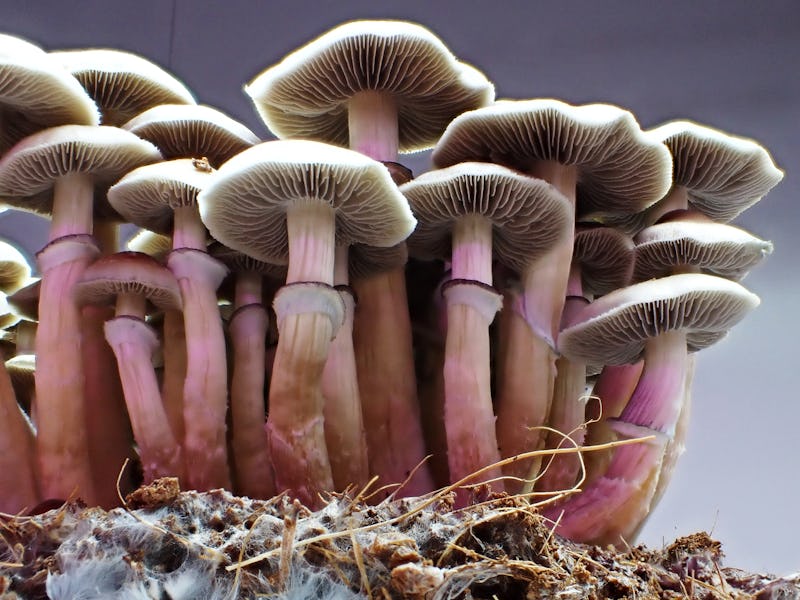Domestication Dramatically Altered Magic Mushrooms’ Genetics, New Study Finds
Inbreeding much?

Google “grow your own magic shrooms,” and you’ll find no end of YouTube tutorials, online books, and less-than-reputable websites. But cultivating these fungi containing psilocybin, a psychedelic compound making waves in neuroscience and mental health therapy, isn’t just about Mason jars and ideal temps — a lot of it drills down to the mushroom’s DNA.
According to a study published Monday in the journal Current Biology, commercially cultivated varieties (or cultivars) of psilocybin mushrooms like Psilocybe cubensis aren’t as genetically diverse as their naturally grown counterparts and show signs of inbreeding. This finding was based on a genomic analysis of 38 different Psilocybe cubensis found growing in the Australian wild compared to 86 commercially available cultivars.
“Whether this happened intentionally, by targeted inbreeding to fix traits over the last half century, or unintentionally through a lack of diversity to cross against is hard to know,” Alistair McTaggart, a mycologist at The University of Queensland in Australia who led the study, said in a press release. “The trailblazers who domesticated magic mushrooms have set the stage for how we can advance cultivation and innovate with shrooms as we improve our understanding of psilocybin and its benefits.”
A genetic head trip
While there are hundreds of hallucinogenic mushrooms, Psilocybe cubensis is the most well-known and has been used by humans since ancient times partly because it’s so easy to grow. In the last several decades, people started cultivating this no-fuss fungus specifically for psilocybin, the chemical that gives the mushroom its famously trippy qualities.
With the fungi being a pan-tropical species, the researchers wanted to figure out when exactly the mushroom was introduced to the Land Down Under as part of a larger project to map out all of Australia’s native magic mushrooms. To answer the question, the researchers traced the fungal genetic family tree and found that Psilocybe cubensis likely hitched a ride in the guts of cattle — possibly from South Africa or India — and was transported and dispersed throughout the continent sometime well before the 1950s.
But another major goal of McTaggart and his colleagues’ new study was understanding how Psilocybe cubensis’s domestication changed its genetic diversity. McTaggart’s team compared the genomes of these wild Psilocybe cubensis to five commercial cultivars: Blue Magnolia, Golden Teacher, Malabar, Luminous Lucy, and Penis Envy (yes, it’s a real mushroom). This analysis revealed that domesticated strains were very closely related to one another and lacked genetic diversity similar to distant cousins. These related genetics likely originate from the same source and/or inbreeding, whether among members of its family or a fungus with itself (called self-fertilization or selfing).
“What was surprising was the extreme [genetic sameness] of some cultivars of magic mushroom,” said McTaggart. “Some of these cultivars have been nearly stripped of any diversity except at their genes controlling sexual reproduction.”
Interestingly, while the genes responsible for psilocybin were almost the same in most commercial mushrooms, the researchers noticed unique variation in these psilocybin genes in the wild Australian mushrooms and a few commercial types like Luminous Lucy, which enjoys a bit more ancestral diversity compared to the others.
The big, lingering question is whether these genetic differences between the wild Aussie Psilocybe cubensis and its commercially inbred cousins actually change the amount or type of psilocybin and its analogs (aka similar compounds) that are produced. If they do, the researchers say this could mean a fungi’s specific genetic makeup might offer different experiences or even have different therapeutic potentials for any range of mental health conditions.
“Magic mushrooms are the cheapest source of psilocybin and may fill a niche in natural drug development,” said McTaggart. “There is yet more to understand about how magic mushrooms produce other compounds that may impact a psilocybin experience, and this will be an exciting area of research to watch unfold.”